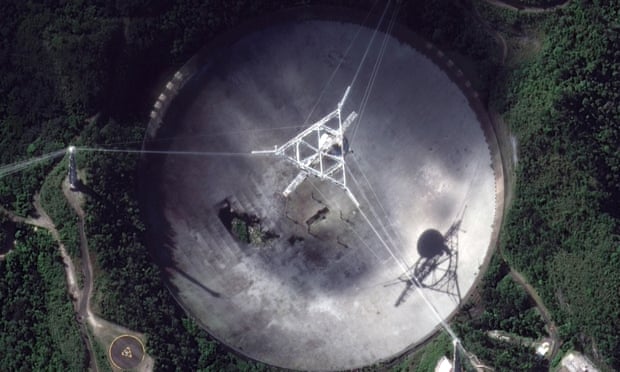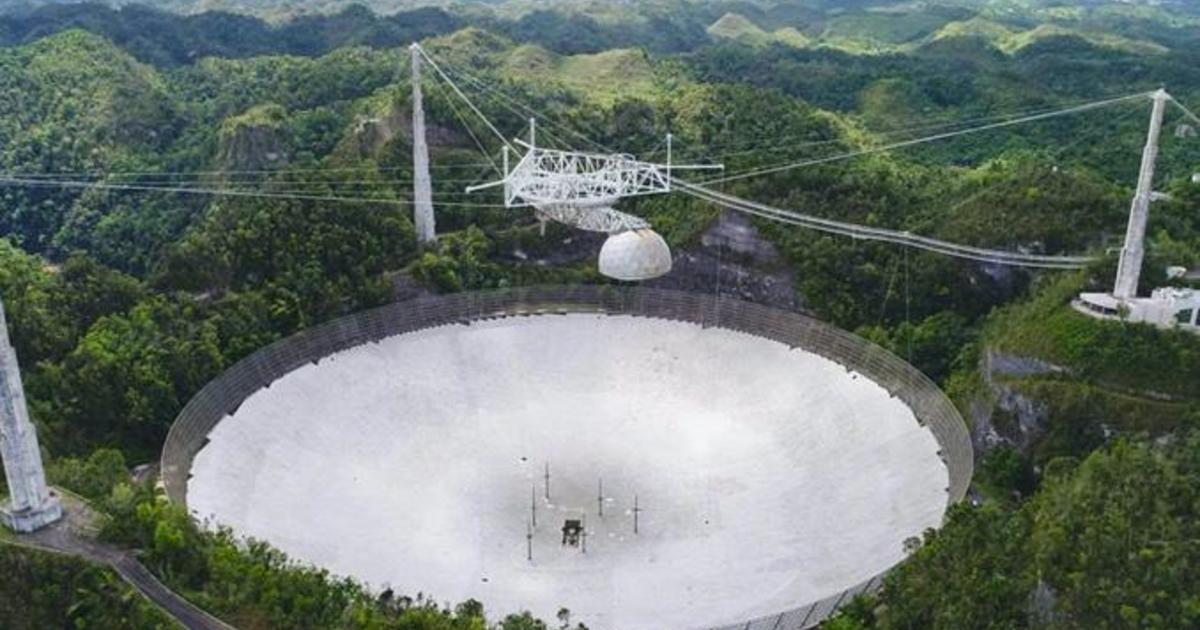The iconic radio telescope built in the jungles of Puerto Rico was the world’s largest for more than half a century.
From the Associated Press, Tuesday, December 1, with additional text from ExpatGo:
A huge radio telescope in Puerto Rico that has played a key role in astronomical discoveries for more than half a century collapsed on Tuesday, officials said.
In the collapse, the telescope’s 900-ton receiver platform fell onto the reflector dish more than 400 feet (122m) below. The loss of the facility ends an era of world-class research and represents a staggering loss to the scientific community.
The US National Science Foundation had earlier announced that the Arecibo Observatory would be closed. An auxiliary cable snapped in August, causing a significant gash on the 1,000 ft-wide (305m) reflector dish and damaged the receiver platform that hung above it. Then a main cable broke in early November.
Though a collapse was recognised as a very real risk following the failure of two critical cables, the event on Tuesday nevertheless shocked many scientists who had relied on what was until recently the largest radio telescope in the world. The destruction of the Arecibo facility will impact not only scores of astronomers and other scientists around the world, but Puerto Rico as well. Many locals have never known life without the huge dish nestled into the undulating jungle-covered terrain, and its economic contributions to Puerto Rico have been substantial.

“It’s a huge loss,” said Carmen Pantoja, an astronomer and professor at the University of Puerto Rico who used the telescope for her doctorate. “It was a chapter of my life.”
Scientists worldwide had been petitioning US officials and others to reverse the NSF’s decision to close the observatory. The NSF said at the time that it intended to eventually reopen the visitor center and restore operations at the observatory’s remaining assets, including its two Lidar facilities used for upper atmospheric and ionospheric research, including analyzing cloud cover and precipitation data.
The telescope was built in the 1960s with money from the US defense department amid a push to develop anti-ballistic missile defenses. The immense dish was constructed in a natural sinkhole in the ground. Arecibo Observatory had endured hurricanes, relentless tropical humidity, and a recent string of earthquakes in its 57 years of operation.
Arecibo’s prodigious legacy includes the detection of the first binary pulsar in 1974 – an important discovery that bolstered a key component of Einstein’s general theory of relativity and that ultimately earned two physicists the 1993 Nobel Prize in physics.
The observatory has been an inspiration to many. For its neighbours in Puerto Rico and for people worldwide, it has been a literal link between the terrestrial and the extraterrestrial. And in movies and art, it has been depicted as both Earth’s doorbell and its peephole into outer space.
The Arecibo Observatory had a prominent role in the 1997 science fiction movie Contact, starring Jodie Foster and Matthew McConaughey, based on the Carl Sagan novel of the same name. The huge reflector dish was also notably used as a climactic set piece in the 1995 James Bond film GoldenEye.
On the side of science rather than entertainment, the Arecibo telescope has been used to search for possible extraterrestrial life in the universe, track asteroids on a path to Earth, conduct the aforementioned research that led to a Nobel Prize, and determine if a given planet is potentially habitable. It has also served as a training ground for graduate students, and even as a tourist attraction, drawing about 90,000 visitors a year.

“I am one of those students who visited it when young and got inspired,” said Abel Mendez, a physics and astrobiology professor at the University of Puerto Rico at Arecibo who has used the telescope for research. “The world without the observatory loses, but Puerto Rico loses even more.”
He last used the telescope on August 6, just days before a socket (the one holding the auxiliary cable that snapped) failed in what experts believe could be a manufacturing error. The National Science Foundation, which owns the observatory that is managed by the University of Central Florida, said crews who evaluated the structure after the first incident determined that the remaining cables could handle the additional weight.
But on November 6, another cable broke. That failure seemed to almost seal the observatory’s fate, though many in the scientific community held out hope for a happy ending.

A spokesman for the observatory said there would be no immediate comment, and a spokeswoman for the University of Central Florida did not return requests for comment.
Scientists had used the telescope to study pulsars to detect gravitational waves as well as search for neutral hydrogen, which can reveal how certain cosmic structures are formed. About 250 scientists worldwide had been using the observatory when it closed in August, including Mendez, who was studying stars to detect habitable planets.
“I’m trying to recover,” he said. “I am still very much affected.”
"ExpatGo welcomes and encourages comments, input, and divergent opinions. However, we kindly request that you use suitable language in your comments, and refrain from any sort of personal attack, hate speech, or disparaging rhetoric. Comments not in line with this are subject to removal from the site. "























